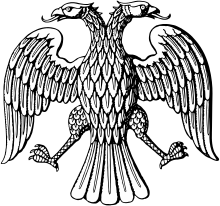Coat of arms of the Russian Provisional Government
The coat of arms of the Russian Provisional Government continued the Russian coat of arms tradition in 1917 with the double-headed eagle.
After the February Revolution of 1917 , the double-headed eagle was recognized as a symbol of Russia. The legal advice of the provisional government recommended adopting this coat of arms. The elements of the tsarist empire were seen as eliminated. For this commission, the double-headed eagle showed no connection to the Romanov dynasty . Crowns and other references to the nobility or the tsarist state system were no longer in the state coat of arms.
It was not until 1918 that a new state coat of arms with completely new coat of arms elements ( hammer and sickle , etc.) was created by a constituent assembly.
President Boris N. Yeltsin reintroduced the double-headed eagle into the national coat of arms of Russia on November 30, 1993, but the Duma did not confirm this coat of arms until December 2000.
description
The black double-headed eagle with a golden beak and stand is red-tongued and silver-armored.
literature
Isabelle de Keghel: The State Symbolism of the New Russia: Traditions, Integration Strategies. Lit.Verlag Dr.W.Hopf, Hamburg 2008, ISBN 978-3-8258-8862-6 .
